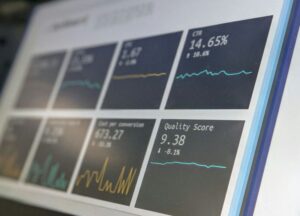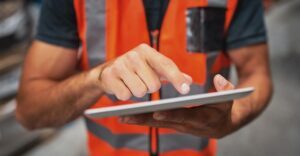What are the practical uses of AI in health and safety, and what next steps can HS professionals take in using AI-driven data? Dakota Murphey takes a look.
The rapid advancement of artificial intelligence (AI) has triggered both waves of excitement and concern across industries. Generative AI in particular has been a prominent topic of conversation among business leaders, leaving a trail of wonder, fear, and excitement in its wake.

Credit: Steve Johnson/Unsplash
In the realm of health and safety, AI has tremendous potential but many are raising ethical concerns and posing legitimate questions about its current and future integration. While many wax lyrical about AI’s ability to streamline processes and improve efficiency, others are rightfully concerned about long-term job displacement and data security with widespread, unsupervised use. Companies – in the health and safety space and beyond – with an aligned organisational structure and a commitment to ethical AI use will likely fare better than those who refuse to acknowledge its benefits.
Therefore, it’s imperative that we shift our perspective and recognise AI as a powerful tool in the spheres of workplace safety and risk mitigation, which, as this article will explore, it can be. How can AI be an asset for good in the evolving and highly regulated health and safety space?
The current landscape of health and safety
The health and safety profession has come a long way, with robust regulations and industry policies in place to safeguard workers and minimise risks across a spectrum of roles. Simultaneously, we have seen a rapid increase in AI tool uptake, and many health and safety firms now use AI in some capacity. Not only is a legislation framework in the works to provide employee protection, but the World Economic Forum’s Future of Jobs Report 2023 found that 50% of surveyed companies expect AI to actually create job growth, including in the health and safety space.
Traditional working processes and methods can, at least when compared to AI-powered automation, be time-consuming, resource-intensive, and prone to human error. From routine paperwork and manual verifications to data analysis and risk assessments, AI can play an instrumental and transformative role in enhancing efficiency across health and safety functions.
The health and safety sector has also been witness to digitisation on a wide scale. Many digital, cloud-based tools help systemise processes and make sense of vast quantities of data and metrics to help professionals make informed decisions. Nowadays, data privacy and personal safety measures extend beyond the physical world and into the cybersphere, with the threat landscape expanding on a wide scale. As such, it’s fair to say that health and safety now must account for a broad range of digital risks as well as those with a physical presence.
Fortunately, AI in its relatively barebones state currently, can be used as a force multiplier for health and safety professionals, thus helping them overcome a variety of physical and digital challenges.
How AI can augment and support health and safety

Credit: Stephen Dawson/Unsplash
Rather than perceiving AI as an imminent threat, health and safety leaders and decision-makers should foster a positive culture that embraces it as a force for good. In any context, AI can amplify and bolster a team’s capabilities and enable them to be more strategic in their resource allocation, while making more informed decisions.
At a basic level, AI can automate the most repetitive and mundane tasks associated with health and safety processes. Imagine that health and safety experts can leverage this with supervision and oversight. In that case, they will ultimately find themselves with more valuable time and resources to spare on more critical, pressing responsibilities that require human input.
AI can be used to good advantage in a health and safety environment in the following ways:
- Predictive analytics: AI algorithms can analyse large quantities of data, including times, dates, incident reports, environmental conditions, behaviour patterns, and more. Aggregating this information helps decisions about risk identification and mitigation be made and actioned more promptly.
- Smart monitoring: Sensors, cameras, and security software can be integrated to continuously monitor work environments, detecting hazards, unsafe practices, and potential violations in real-time, as this research paper has found. From this human supervisors can intervene immediately and take preventative or corrective action.
- Injury prevention: By analysing granular data, AI tools can help to identify the most high-risk areas and activities that could cause severe or catastrophic injuries. Identifying problem areas allows teams to implement workarounds, warning signs, and safety measures to prevent them from worsening.
- Incident investigation: AI can assist in root cause analysis by rapidly processing data from multiple sources, identifying patterns, and providing insights that human analysts may have overlooked.
- Compliance management: AI-powered systems can help ensure adherence to complex regulatory requirements by automating compliance checks, documentation, and reporting processes, reducing the risk of costly fines and penalties.
Addressing moral panic about AI
Despite the evident benefits of using AI, widespread concerns about AI’s impact on employment and workplace stability are completely understandable. Given that many industry leaders and experts are even vastly unaware of what AI’s long-term potential could look like, immediate fears and worries need to be addressed proactively to provide reassurance and peace of mind.
The general consensus among leaders in health and safety and beyond is that they agree AI is a tool designed to augment and support human workers. AI lacks intuition, context, and empathy, which means it cannot be considered an adequate entire replacement for a human.
 Health and safety professionals – among millions of others – will remain indispensable while AI as a whole remains a rather rudimentary tool. Their expertise, judgements, and skills are vital for interpreting complex situations and problems, and while AI can definitely help in multiple facets of how they achieve their goals, it cannot replace them entirely. It’s a health and safety professional’s job to interpret any AI-derived data and outputs and develop appropriate solutions and strategies from them.
Health and safety professionals – among millions of others – will remain indispensable while AI as a whole remains a rather rudimentary tool. Their expertise, judgements, and skills are vital for interpreting complex situations and problems, and while AI can definitely help in multiple facets of how they achieve their goals, it cannot replace them entirely. It’s a health and safety professional’s job to interpret any AI-derived data and outputs and develop appropriate solutions and strategies from them.
Furthermore, one important thing to remember is that AI systems are only as effective as the data they are trained on. AI systems have been known to propagate biases and misinformation as they lack contextual awareness, instead serving the specific needs of a command or prompt. This lack of intuition means that generative AI outputs cannot be left entirely to their own devices, and human oversight and supervision will remain critical for years to come.
Therefore, it’s crucial to ensure that AI is deployed responsibly and in alignment with organisational values, policies, and societal norms. Failing to uphold ethical AI principles and to prevent AI misinformation from proliferating can open organisations to statutory or public scrutiny.
Best practices for AI implementation in health and safety
To harness the power of AI while mitigating possible risks, organisations should approach AI thoughtfully and strategically. Below are a few steps worth bearing in mind:
- Establish an AI use policy and governance framework for its use in a health and safety context.
- Involve health and safety stakeholders and staff early on in the implementation and testing process.
- Provide comprehensive AI upskilling and training programmes to help staff understand and utilise tools.
- Pilot AI tools in controlled environments or projects to assess effectiveness before integrating them across an organisation.
- Continuously monitor, analyse, and gather feedback about its helpfulness and that it is functioning as intended.
As we continue to navigate the technological innovation of AI, it’s vital to address concerns transparently and welcome discussions about its place in health and safety. The future of this sector is evolving, and companies that embrace it as a catalyst for safer workplaces and positive change will be best positioned to lead the way forward, by example.
The Safety Conversation Podcast: Listen now!
The Safety Conversation with SHP (previously the Safety and Health Podcast) aims to bring you the latest news, insights and legislation updates in the form of interviews, discussions and panel debates from leading figures within the profession.
Find us on Apple Podcasts, Spotify and Google Podcasts, subscribe and join the conversation today!



 Health and safety professionals – among millions of others – will remain indispensable while AI as a whole remains a rather rudimentary tool. Their expertise, judgements, and skills are vital for interpreting complex situations and problems, and while AI can definitely help in multiple facets of how they achieve their goals, it cannot replace them entirely. It’s a health and safety professional’s job to interpret any AI-derived data and outputs and develop appropriate solutions and strategies from them.
Health and safety professionals – among millions of others – will remain indispensable while AI as a whole remains a rather rudimentary tool. Their expertise, judgements, and skills are vital for interpreting complex situations and problems, and while AI can definitely help in multiple facets of how they achieve their goals, it cannot replace them entirely. It’s a health and safety professional’s job to interpret any AI-derived data and outputs and develop appropriate solutions and strategies from them.